| کد مقاله | کد نشریه | سال انتشار | مقاله انگلیسی | نسخه تمام متن |
|---|---|---|---|---|
| 7498298 | 1485859 | 2018 | 19 صفحه PDF | دانلود رایگان |
عنوان انگلیسی مقاله ISI
Examining the role of trip destination and neighborhood attributes in shaping environmental influences on children's route choice
ترجمه فارسی عنوان
بررسی نقش مقصد سفر و ویژگی های محله در شکل دادن تأثیرات محیطی بر انتخاب مسیر کودکان
دانلود مقاله + سفارش ترجمه
دانلود مقاله ISI انگلیسی
رایگان برای ایرانیان
کلمات کلیدی
انتخاب مسیر، پیروزی، فرزندان، پیاده روی برای حمل و نقل،
ترجمه چکیده
مسیرها یک راه معمولی هستند که از طریق آن کودکان عابر پیاده محیط زیست را تجربه می کنند. با این حال، شواهد تجربی در مورد مسیر مقیاس تاثیر محیط زیست بر روی راه رفتن کودکان است کمی و عمدتا مربوط به برنامه های سفر خانه های مدرسه است. برای رسیدگی به این شکاف، این مطالعه با هدف شناسایی تاثیرات محیطی بر انتخاب مسیر کودکان و بررسی اینکه چگونه این می تواند با نوع سفر و نوع محله متفاوت باشد. یکصد و هفت کودک (10 تا 12 ساله) که در داخل شهر زندگی می کنند و محله های حومه ای خوشه ای در ریچون لزیون، اسرائیل در این مطالعه شرکت کردند. شرکت کنندگان آموزش داده شد تا راههایی را که به طور منظم از خانه خود به چهار مقصد هدایت می شوند، آموزش دهند: مدرسه، ساختمان عمومی، خرده فروشی و پارک. سپس ویژگی های محیط ساخته شده برای سفرهای پیاده روی گزارش شده، نسبت به سفرهایی که کوتاه ترین مسیر در خیابان، مسیر و شبکه کوچه برای هر جفت مبدا و مقصد را با استفاده از رگرسیون لجستیک شرطی در نظر گرفت، در حالیکه برای همبستگی بین انتخاب ها، طول مسیر و ویژگی های فردی. مقایسه مسیرهای انتخاب شده و غیر انتخاب شده نشان می دهد که مسیرهایی با تقاطعات کمتر، انتخاب می شوند، اگر آنها تقاطع های کوچکتری داشته باشند، اما شکل جمع و جور شهری در طول مسیر. نسبت مساحت و فاصله ساخته شده به مساحت، همچنان معنی دار بود، اما با استفاده از نمونه های مقصد و محله طبقه بندی شد، اما استفاده از زمین های مسکونی و شاخص پیاده روی به شیوه انتخابی متفاوت بود. در ابتدا مطالعه ای برای کشف مسیر انتخاب شده توسط هر دو محل و مقصد و با توجه به اینکه تاثیرات محیطی در پیاده روی به طور خاص مشخص می شود، این مطالعه بینش های ارزشمندی را درباره تعاملات رفتاری محیطی ارائه می دهد.
موضوعات مرتبط
علوم زیستی و بیوفناوری
علوم محیط زیست
علوم زیست محیطی (عمومی)
چکیده انگلیسی
Routes are a common way through which child pedestrians experience the built environment. However, empirical evidence on route-scale environmental influences on children's walking are scarce and mainly concern home-school itineraries. To address this gap, this study aims to identify environmental influences on children's route choice, and to explore how these may vary by trip destination and neighborhood type. One hundred and seven children (10-12â¯year old) living in inner-city and clustered suburban neighborhoods in Rishon LeZion, Israel participated in the study. Participants were instructed to draw the routes along which they regularly walk from their home to four destinations: School, public facility, retail and park. We then compared the attributes of the built environment for the walking trips reported, relative to the trips that would have taken the shortest path along the street, path, and alley network for each origin-destination pair using conditional logistic regression, while adjusting for the correlation across choices, route length, and individual characteristics. Comparisons of chosen and non-chosen routes suggest that routes with fewer intersections are more likely to be selected, if they have fewer intersections but more compact urban form along the route. The ratio of built-to-lot area and distance remained significant, but residential land uses and the walkability index were differentially associated with route choice when analyses were stratified by destination and neighborhood type. Being the first study to explore route choice by both location and destination and given that environmental influences on walking are context specific, this study provides valuable insights on environment-behavior interactions.
ناشر
Database: Elsevier - ScienceDirect (ساینس دایرکت)
Journal: Transportation Research Part D: Transport and Environment - Volume 65, December 2018, Pages 63-81
Journal: Transportation Research Part D: Transport and Environment - Volume 65, December 2018, Pages 63-81
نویسندگان
Mika R. Moran, Daniel A. RodrÃguez, Jason Corburn,
